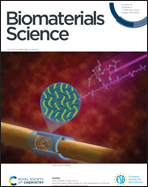Retracted Article: A near-infrared laser and H2O2 activated bio-nanoreactor for enhanced photodynamic therapy of hypoxic tumors†
Abstract
Hypoxic resistance, photosensitizer toxicity, and target deficiency are major challenges strongly inhibiting the efficacy of clinical photodynamic therapy (PDT) in tumor treatment. To overcome these challenges, we synthesized IR780 and catalase co-loaded liposomes to form a tumor-targeted bio-nanoreactor (LIP-IR-CAT). The efficient strategy can solve the physicochemical problems including strong hydrophobicity, poor light stability, poor tolerance, and high toxicity in vivo of IR780 as a photosensitizer and promote the clinical application of IR780. Taking advantage of the high catalytic efficiency of catalase when it meets hydrogen peroxide (H2O2), continuous oxygen can be generated due to the abnormally elevated level of H2O2 within the tumor, thus remarkably promoting tumor oxygenation. With the conjunction of photosensitivity and specific mitochondria-targeting ability of IR780, the intratumoral reactive oxygen species (ROS) are strongly enhanced, and adenosine triphosphate (ATP) is reduced under near-infrared (NIR) laser irradiation. Following a single-dose intravenous injection of LIP-IR-CAT, tumor hypoxia can be seriously attenuated, at the same time creating an opportunity to enhance the efficacy of PDT on the tumor. Our in vivo data show that the nanoreactor LIP-IR-CAT, in combination with just two short time NIR laser irradiation sessions, can effectively inhibit the growth of solid tumors without systemic toxicity.



 Please wait while we load your content...
Please wait while we load your content...